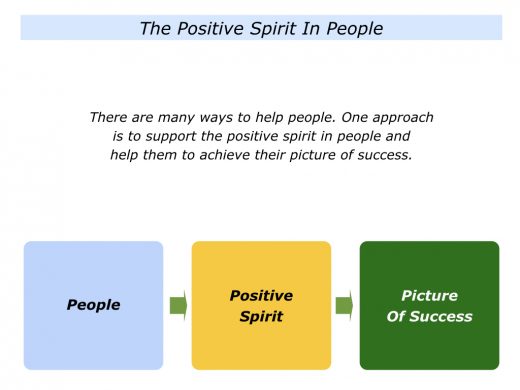
There are many ways to help people to reach their goals. Sometimes I am asked how I try to do this my work. There is a professional answer to this question, which is that the aim is:
To provide practical tools that people can use to build on their strengths and achieve their picture of success.
It is then important to give real-life examples of how this approach has worked for individuals, teams and organisations. It is also to give concrete examples that resonate with those asking the question.
There is another answer to the question. Looking back at the work I have done over the past 50 years, one aim has been:
To support the positive spirit in people and help them to achieve their picture of success.
This sounds vague, but it can be translated into a practical approach. It involves helping people, teams or organisations to focus on:
The specific times when they show positive energy, do satisfying work or achieve success;
The specific principles they follow then to show positive energy, do satisfying work or achieve success;
The specific things they can do to follow these principles in the future – plus maybe add other skills – to show positive energy, do satisfying work or achieve success.
The approach goes beyond focusing on principles. It involves providing people with practical tools they can use to build on their strengths, build super teams or build superb organisations.
Looking back at your own life, can you think of a time when you aimed to support the positive spirit in people? You may have done this when helping a person, team or organisation.
What did you do to spot the positive energy in people? What did you then do to encourage people? What happened as a result of taking these steps?
If you wish, try tackling the exercise on this theme. This invites you to do the following things.
Describe a specific situation in the past when you aimed to support the positive spirit in a person, team or organisation.
Describe the specific things you did then to support their positive spirit.
Describe the specific things that happened as a result of taking these steps.
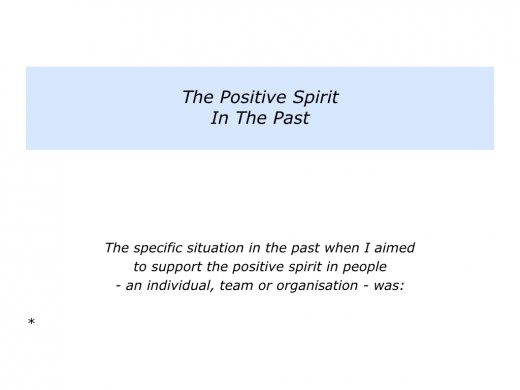
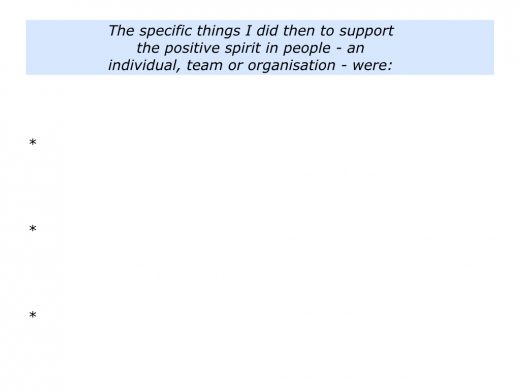
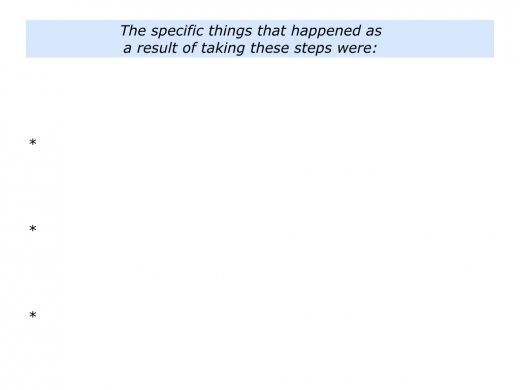
Supporting the
positive spirit in people
How to support the positive spirit in individuals? One approach is to watch a person and ask the following questions.
When does the person come alive? When do they demonstrate positive energy? When are they in their element – at ease and yet able to excel? What are the activities in which they deliver As rather than Bs or Cs?
When do they go into another dimension? When do they go through the stages of absorption, adventure and achievement? When do they see the destination quickly? When do they go ‘A, B … and then leap to …Z?
When do they do make complicated things appear simple? What are the situations in which they see patterns quickly? When do they do the basics and then add the brilliance? When do they add that touch of class?
When do they encourage other people? When are they kind and generous? When do they make others feel the centre of their world? What do they do then to help other people? What happens as a result of them taking these steps?
When does the person demonstrate positive spirit? What do they do right then? What are the principles they follow? How can they follow these principles to do satisfying work, overcome setbacks or achieve their picture of success?
These are useful questions to ask when helping people to build on their strengths, do superb work or build super teams. If appropriate, the next step is to provide practical tools they can use to achieve their picture of success.
During a recent super teams workshop, for example, we began by each person describing the kinds of work they found most satisfying. They then moved on to clarifying their strengths and best contributions to the team.
Here is the first exercise in which people described the kinds of work they found satisfying. This helped to then channel their positive spirit towards achieving the goals.
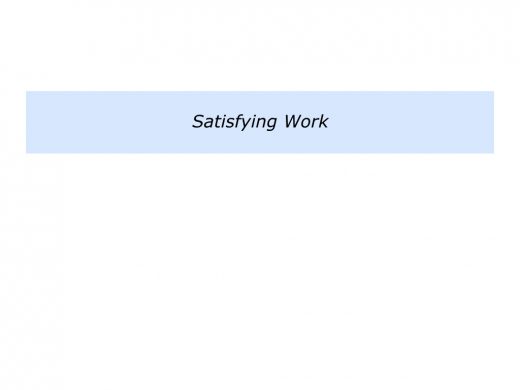
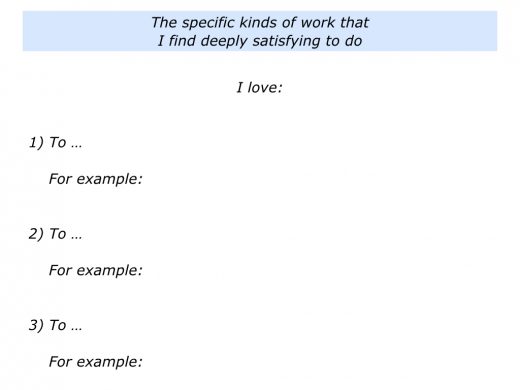
Supporting the
positive spirit in teams
How to support the positive spirit in teams? One approach is to explore the team’s positive history and when people have performed brilliantly. This is a theme I often explore when clarifying how people can continue to build a super team.
Super teams communicate the team’s purpose, principles and picture of success. They then give people the chance to reflect and decide if they want to contribute. If so, they encourage people to build on their strengths and clarify their best contributions.
Such teams are often made up of people who choose to have a positive attitude and be professional. They also want to perform superb work and do their best to help the team to succeed.
Super teams make clear contracts with people about the results they will deliver towards achieving the goals. They also give people the support they need to deliver the goods.
Such teams then manage by outcomes rather than by tasks. They encourage people to co-ordinate their strengths, perform superb work and find solutions to challenges. People then do whatever is required to achieve the picture of success.
Let’s return to finding the positive spirit in teams. Here is an exercise that I often use at the beginning of workshops. People are invited to do the following things.
Describe the specific times in the past when people in the team have performed brilliantly.
Describe the specific things that people did then – the principles they followed – to perform brilliantly.
Describe the specific things that people can do to follow some of these principles in the future to perform brilliantly.
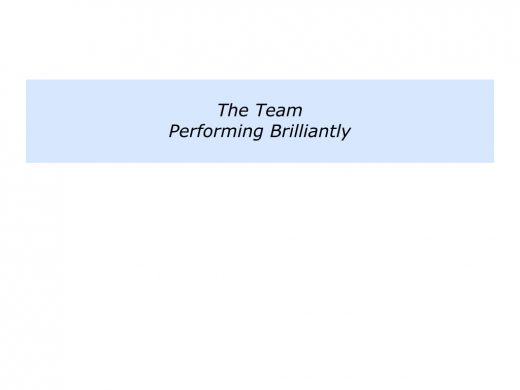
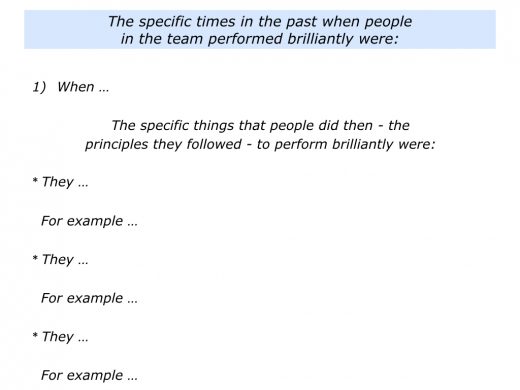
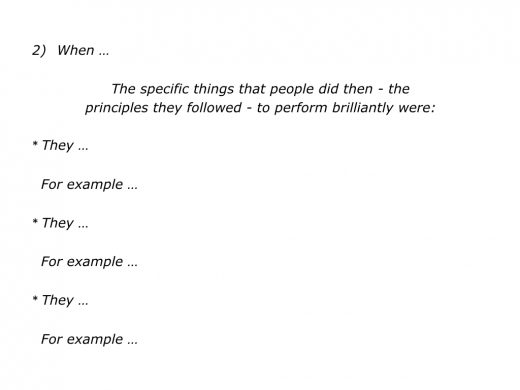
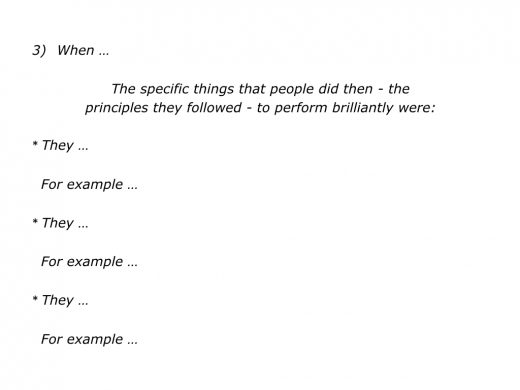
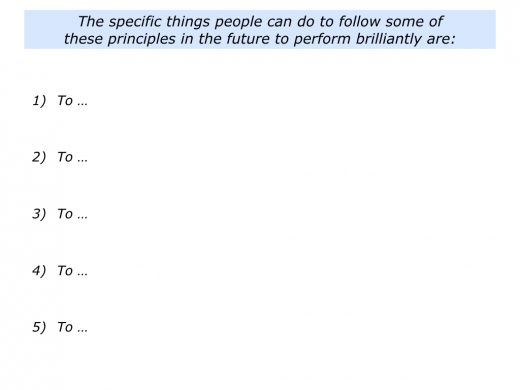
Supporting the positive
spirit across the planet
There are many ways to support the positive spirit in people across the planet. Erik Erikson, the psychologist, described how some people do this by becoming more generous as they grew older.
Individuals begin to move into what he called The Generative Age. He described this as ‘a concern for establishing and guiding the next generation’.
Many people choose to take this path earlier in life. Some people do it by being kind and generous in their daily lives. Some people do it as parents. They aim to create a positive environment for their children.
Some people do it in their work. They aim to do satisfying work that helps other people. Some people do it by aiming to ensure that future generations inherit a beautiful world.
Today many people are doing pioneering work by running social enterprises. They are sometimes backed by organisations such as the Ashoka Organization, Echoing Green and the Unreasonable Group.
Such people often highlight what is working by producing success stories. They recognise that people buy success rather than the theory of success. Seeing what works can encourage people to adopt an approach that is likely to deliver positive results.
David Cooperrider is somebody who encourages this approach. Best known for his pioneering work with Appreciative Inquiry, he continues to apply the strengths approach to helping people to achieve success.
In the following video he describes how this approach can help the human family to develop. You can discover more about David’s work on his website. Here is the link.
http://www.davidcooperrider.com/
Let’s return to your own life and work. Can you think of a situation in the future when you may want to encourage the positive spirit in people?
You may want to do this when helping a person, team or organisation. You may do it when acting as a parent, friend, educator, leader, mentor, trusted advisor or in another role.
What can you do then to spot the positive spirit in people? How can you encourage them to channel this energy? How can you help them to clarify their aims and then take practical steps to achieve their picture of success?
If you wish, try tackling the exercise on this theme. This invites you to do the following things.
Describe a specific situation in the future when you may aim to support the positive spirit in a person, team or organisation.
Describe the specific things you can do then to support their positive spirit.
Describe the specific things that may happen a result of taking these steps.
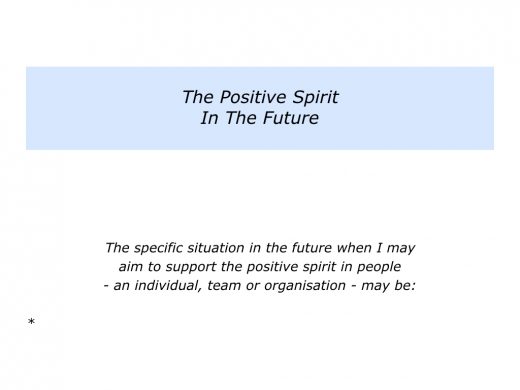
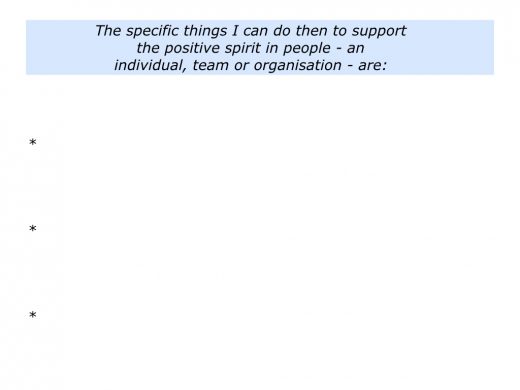
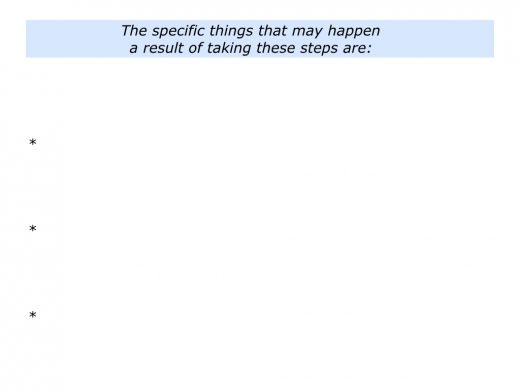






Leave a Reply